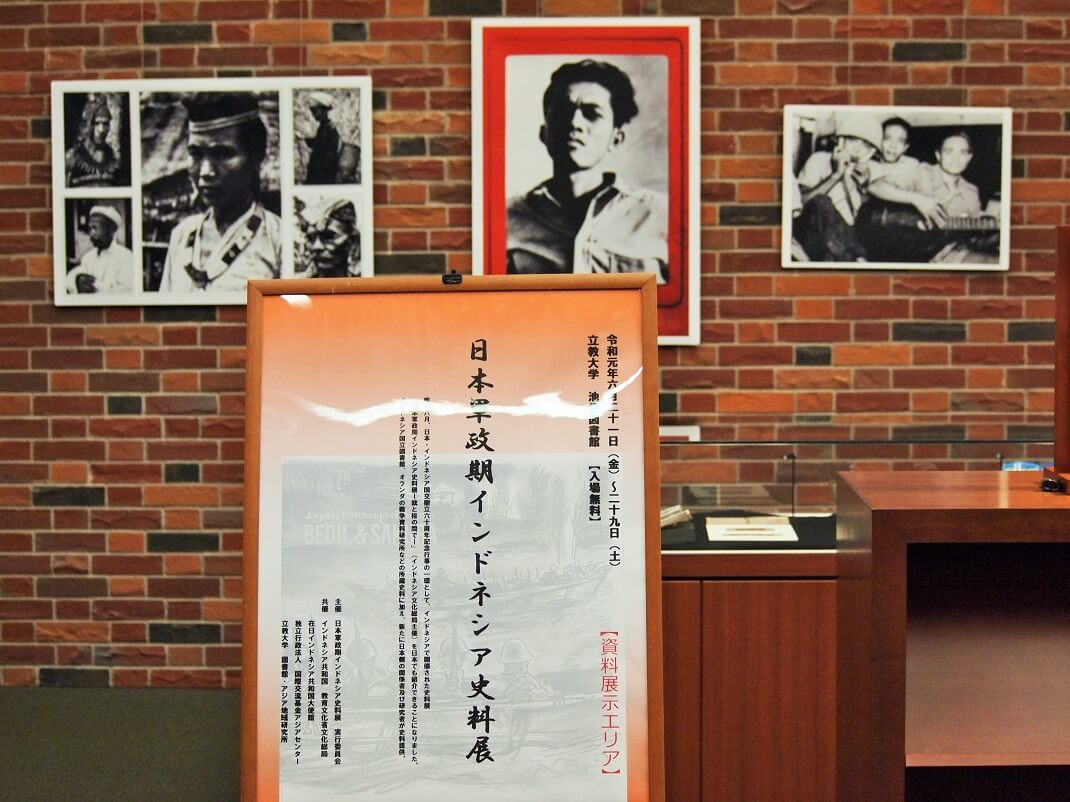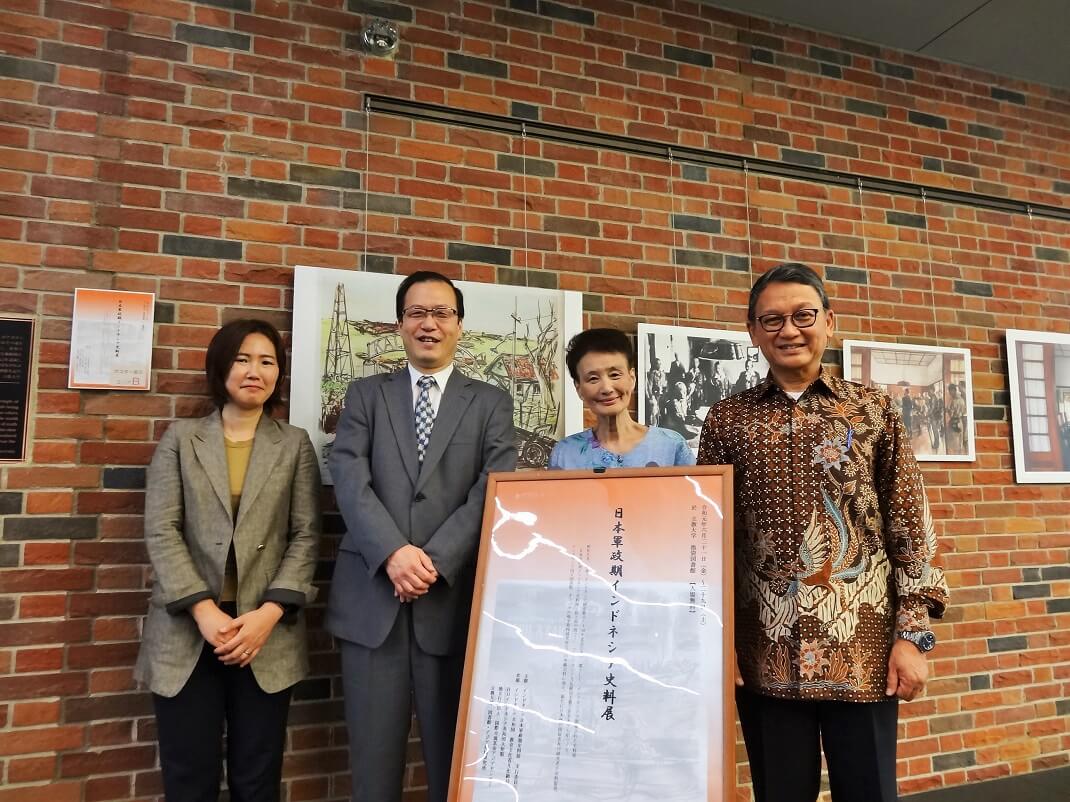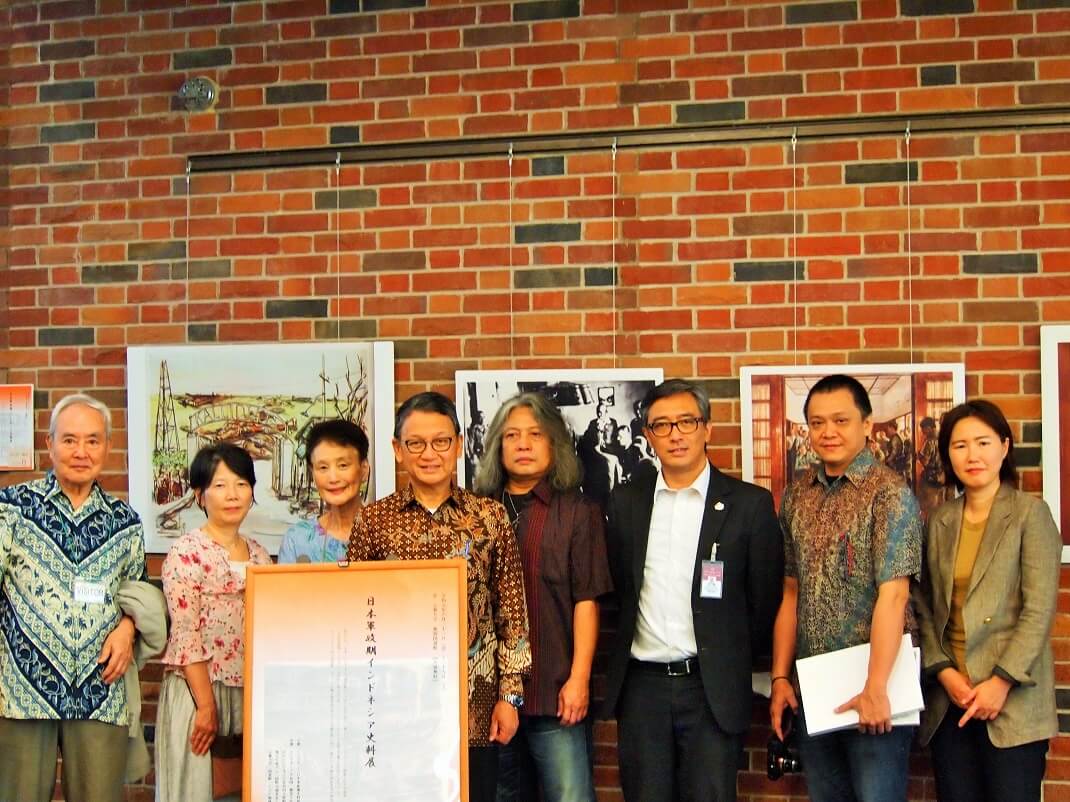Aug 29, 2019
Indonesian ambassador visits archives exhibition on the Japanese military-rule period of Indonesia held at Rikkyo University Library
Keyword:INFORMATION
OBJECTIVE.
The Indonesian Extraordinary and Plenipotentiary Ambassador to Japan, Arifin Tasrif, visited the “Indonesian materials exhibition under Japanese Occupation” on June 21, 2019, attending the first day of the nine-day long exhibition held till June 29 at Rikkyo University’s Ikebukuro Library.

The exhibition was organized by the Executive committee of Indonesian materials exhibition under Japanese Occupation and supported by the Indonesian Embassy in Tokyo and Rikkyo University. A similar exhibition called the “Indonesian materials exhibition under Japanese Occupation: In Between Guns and Sakura,” was held in Indonesia last August as part of the events commemorating the 60th anniversary of the establishment of diplomatic relations between Japan and Indonesia. The Indonesian event was organized by Indonesia’s Directorate General of Culture. The decision was made to hold a similar exhibition in Tokyo to introduce its content to audiences in Japan.
In addition to archived materials from the National Library of Indonesia and the Netherlands Institute for War Documentation, the Tokyo exhibition displayed new materials provided by researchers and other parties in Japan. The materials on display included posters, publications, manga cartoons and photographs which the Japanese military had used for propaganda during its rule of Indonesia at the time of World War II. Also shown at the exhibition were drawings painted and photographs taken, independent of the intentions of the Japanese military or government, by Japanese individuals in Indonesia during the military rule.
In his remarks made during the inauguration of the exhibition, Ambassador Arifin Tasrif expressed his gratitude for the exhibition being held and the expectations he had for people to become aware of the importance of learning history. (Full text of his remarks have been provided at the end of this story) Library Dean Yuriko Nakamura (Chair of the Librarian Course among Certification Courses and a College of Arts professor) then thanked Keio University Professor Emeritus Aiko Kurasawa who heads the Executive committee of Indonesian materials exhibition under Japanese Occupation who strove to make this exhibition possible. Nakamura also said that Rikkyo University was very honored to be able to hold the exhibition at the library.
In addition to archived materials from the National Library of Indonesia and the Netherlands Institute for War Documentation, the Tokyo exhibition displayed new materials provided by researchers and other parties in Japan. The materials on display included posters, publications, manga cartoons and photographs which the Japanese military had used for propaganda during its rule of Indonesia at the time of World War II. Also shown at the exhibition were drawings painted and photographs taken, independent of the intentions of the Japanese military or government, by Japanese individuals in Indonesia during the military rule.
In his remarks made during the inauguration of the exhibition, Ambassador Arifin Tasrif expressed his gratitude for the exhibition being held and the expectations he had for people to become aware of the importance of learning history. (Full text of his remarks have been provided at the end of this story) Library Dean Yuriko Nakamura (Chair of the Librarian Course among Certification Courses and a College of Arts professor) then thanked Keio University Professor Emeritus Aiko Kurasawa who heads the Executive committee of Indonesian materials exhibition under Japanese Occupation who strove to make this exhibition possible. Nakamura also said that Rikkyo University was very honored to be able to hold the exhibition at the library.
Outline of the exhibition

From left, Library Dean Yuriko Nakamura, Rikkyo University President Yangchoon Kwak, Keio University Professor Emeritus Aiko Kurasawa and Indonesian Ambassador to Japan Arifin Tasrif.
Title: “Indonesian materials exhibition under Japanese Occupation”
Organizer: Executive committee of Indonesian materials exhibition under Japanese Occupation
Supporters: Indonesia’s Directorate General of Culture, Indonesian Embassy in Tokyo, Japan Foundation’s Asia Center, Rikkyo University’s Centre for Asian Area Studies and the library
Venue: Rikkyo University’s Ikebukuro Library (Ground-level, 1st and 2nd floors)
Exhibition content:
In August 2018, the “Indonesian materials exhibition under Japanese Occupation: In Between Guns and Sakura” was held by Indonesia’s Directorate General of Culture as part of the events commemorating the 60th anniversary of the establishment of diplomatic relations between Japan and Indonesia. The exhibition attracted a huge crowd and received good responses from the visitors. Later, many people voiced their desire to hold such an exhibition in Japan which led to the formation of the Executive committee of Indonesian materials exhibition under Japanese Occupation. It was made possible by the funding provided by the Japan Foundation and collaborations from many other parties. The materials on display were a collection of posters, publications, manga cartoons and photographs which the Japanese military had used for propaganda during its rule of Indonesia in World War II. Also exhibited were drawings painted and photographs taken, independent of the intentions of the Japanese military or government, by Japanese individuals in Indonesia during the military rule. The term “military rule” tends to conjure up an image of a ruler with iron fist, holding people at gunpoint. The Director General of Culture, Hilmar Farid, who is a historian himself, made extensive efforts to organize this exhibition, which was designed to provide a closer look at the Japanese occupation of Indonesia from multiple perspectives.
The materials on displays were mainly from the National Library of Indonesia and the Netherlands Institute for War Documentation, in addition to the materials provided by researchers and other parties in Japan.
Organizer: Executive committee of Indonesian materials exhibition under Japanese Occupation
Supporters: Indonesia’s Directorate General of Culture, Indonesian Embassy in Tokyo, Japan Foundation’s Asia Center, Rikkyo University’s Centre for Asian Area Studies and the library
Venue: Rikkyo University’s Ikebukuro Library (Ground-level, 1st and 2nd floors)
Exhibition content:
In August 2018, the “Indonesian materials exhibition under Japanese Occupation: In Between Guns and Sakura” was held by Indonesia’s Directorate General of Culture as part of the events commemorating the 60th anniversary of the establishment of diplomatic relations between Japan and Indonesia. The exhibition attracted a huge crowd and received good responses from the visitors. Later, many people voiced their desire to hold such an exhibition in Japan which led to the formation of the Executive committee of Indonesian materials exhibition under Japanese Occupation. It was made possible by the funding provided by the Japan Foundation and collaborations from many other parties. The materials on display were a collection of posters, publications, manga cartoons and photographs which the Japanese military had used for propaganda during its rule of Indonesia in World War II. Also exhibited were drawings painted and photographs taken, independent of the intentions of the Japanese military or government, by Japanese individuals in Indonesia during the military rule. The term “military rule” tends to conjure up an image of a ruler with iron fist, holding people at gunpoint. The Director General of Culture, Hilmar Farid, who is a historian himself, made extensive efforts to organize this exhibition, which was designed to provide a closer look at the Japanese occupation of Indonesia from multiple perspectives.
The materials on displays were mainly from the National Library of Indonesia and the Netherlands Institute for War Documentation, in addition to the materials provided by researchers and other parties in Japan.

Exhibited materials

The Indonesian ambassador and his entourage
Other News
-
Jul 22, 2025
Message
Indonesian Extraordinary and Plenipotentiary Ambassador to Japan
Arifin Tasrif
I am very much pleased to see such an archive exhibition is realized and to be able to declare its opening today. History is very important. Young generations should respect history and pass on the accounts of history to future generations. In particular, Japanese and Indonesian people, who are involved in these endeavors, should be given much credit. In Japan, there have been considerable progresses in Indonesian studies. For example, Professor Aiko Kurasawa has dedicated her study to researching on bilateral relationship between Japan and Indonesia, in particular history between 1942 and 1945. Of noteworthy is that she uses many primary historical sources. What we exhibited at the library are such primary historical sources.
Indonesia puts importance to friendship with Japan, and it is evidenced in the fact that Indonesia uses the term “military occupation” – rather than “colonial rule” – to describe the Japanese military’s involvement in Indonesia. I hope this exhibition will provide a good opportunity to let people know about the importance of learning history.